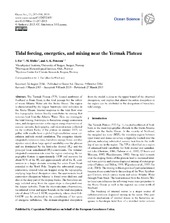| dc.contributor.author | Fer, Ilker | |
| dc.contributor.author | Müller, Malte | |
| dc.contributor.author | Peterson, Algot Kristoffer | |
| dc.date.accessioned | 2015-12-28T09:31:32Z | |
| dc.date.available | 2015-12-28T09:31:32Z | |
| dc.date.issued | 2015-03-27 | |
| dc.Published | Ocean Science 2015, 11:287-304 | eng |
| dc.identifier.issn | 1812-0792 | en_US |
| dc.identifier.uri | https://hdl.handle.net/1956/10818 | |
| dc.description.abstract | The Yermak Plateau (YP), located northwest of Svalbard in Fram Strait, is the final passage for the inflow of warm Atlantic Water into the Arctic Ocean. The region is characterized by the largest barotropic tidal velocities in the Arctic Ocean. Internal response to the tidal flow over this topographic feature locally contributes to mixing that removes heat from the Atlantic Water. Here, we investigate the tidal forcing, barotropic-to-baroclinic energy conversion rates, and dissipation rates in the region using observations of oceanic currents, hydrography, and microstructure collected on the southern flanks of the plateau in summer 2007, together with results from a global high-resolution ocean circulation and tide model simulation. The energetics (depth-integrated conversion rates, baroclinic energy fluxes and dissipation rates) show large spatial variability over the plateau and are dominated by the luni-solar diurnal (K1) and the principal lunar semidiurnal (M2) constituents. The volume-integrated conversion rate over the region enclosing the topographic feature is approximately 1 GW and accounts for about 50% of the M2 and approximately all of the K1 conversion in a larger domain covering the entire Fram Strait extended to the North Pole. Despite the substantial energy conversion, internal tides are trapped along the topography, implying large local dissipation rates. An approximate local conversion–dissipation balance is found over shallows and also in the deep part of the sloping flanks. The baroclinic energy radiated away from the upper slope is dissipated over the deeper isobaths. From the microstructure observations, we inferred lower and upper bounds on the total dissipation rate of about 0.5 and 1.1 GW, respectively, where about 0.4–0.6 GW can be attributed to the contribution of hot spots of energetic turbulence. The domain-integrated dissipation from the model is close to the upper bound of the observed dissipation, and implies that almost the entire dissipation in the region can be attributed to the dissipation of baroclinic tidal energy. | en_US |
| dc.language.iso | eng | eng |
| dc.publisher | Copernicus Publications | en_US |
| dc.rights | Attribution CC BY | eng |
| dc.rights.uri | http://creativecommons.org/licenses/by/3.0 | eng |
| dc.subject | Yermak Plateau | eng |
| dc.subject | Tidal forcing | eng |
| dc.title | Tidal forcing, energetics, and mixing near the Yermak Plateau | en_US |
| dc.type | Peer reviewed | |
| dc.type | Journal article | |
| dc.date.updated | 2015-10-16T12:06:30Z | |
| dc.description.version | publishedVersion | en_US |
| dc.rights.holder | Copyright Author(s) 2015 | en_US |
| dc.identifier.doi | https://doi.org/10.5194/os-11-287-2015 | |
| dc.identifier.cristin | 1259819 | |
| dc.relation.project | Norges forskningsråd: 229786 | |
| dc.subject.nsi | VDP::Matematikk og Naturvitenskap: 400 | en_US |

